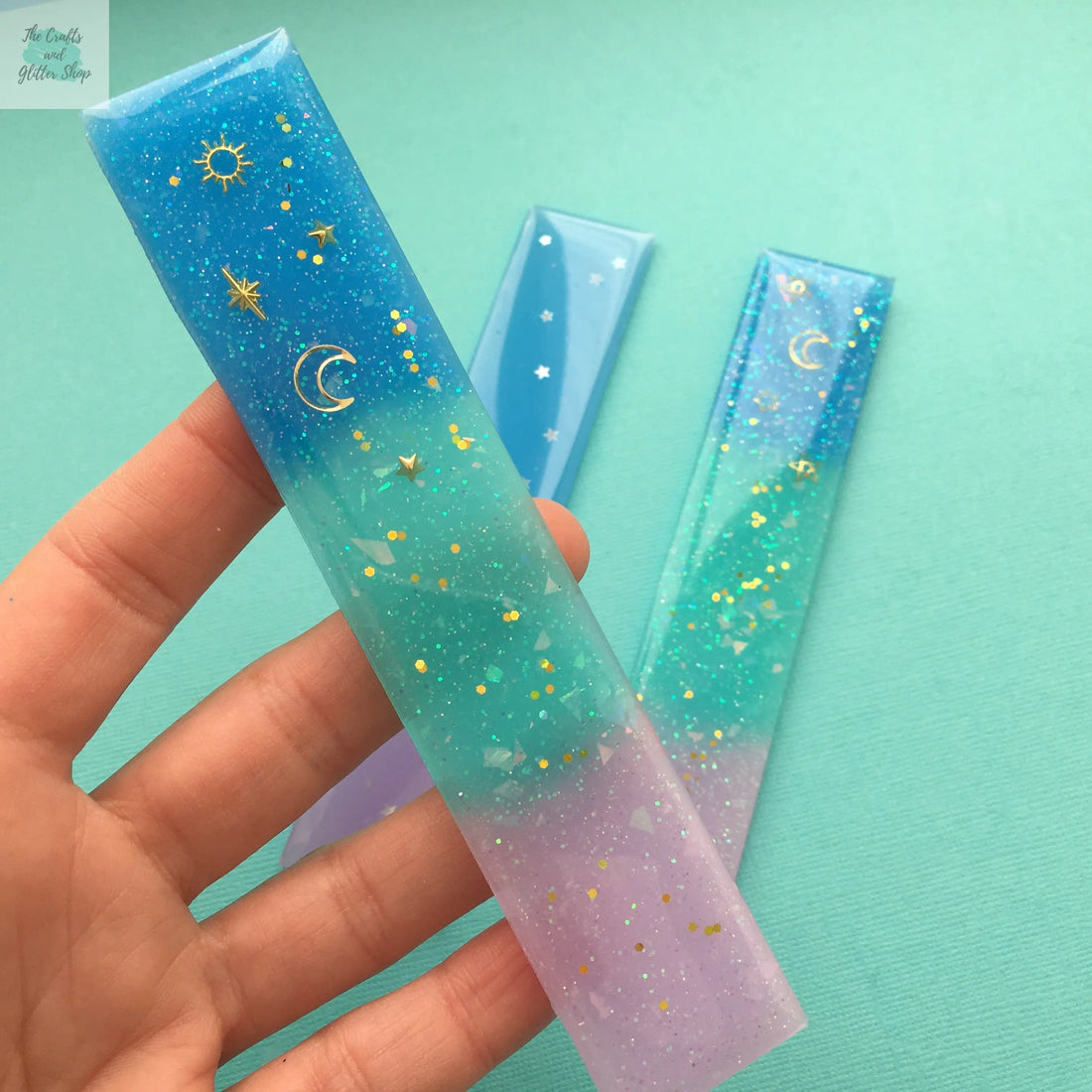
What is the difference between epoxy resin and UV resin?
Share
Before starting on your resin crafting journey you need to decide whether epoxy resin or UV resin is the right option for you. In this article, I will go through the practical differences of both products to help you decide which resin type is best for your needs.
Epoxy resin is made up of 2 parts: resin and a hardener. These two parts need to be mixed together for the curing process to start. On the other hand, UV resin is made up of only 1 part and is ready to use straight away without any mixing required. The curing process for UV resin starts with UV exposure - hence it's name.
Curing methods
As I've already briefly explained, epoxy resin and UV resin have different curing methods.
When using epoxy resin, you will need to mix the two liquids (part A + part B) according to the ratio stated by the resin brand you are using. Most epoxy resins have a 1:1 ratio, but there are other ratios as well, for example a 2:1 ratio. Both parts are mixed and the curing process starts.
UV resin is instantly ready to use. Curing process starts when the resin is exposed to UV or sunlight.
Curing methods - Things to consider:
- it's crucial that both parts of the epoxy resin are measured as accurately as possible to the ratio it requires for curing, otherwise the resin will not cure - you might end up with uncured resin varying in type from having a gloopy mess, sticky resin or bendy resin pieces.
- for UV resin you'll need a UV lamp. The stronger wattage the lamp has, the better results you'll have. You can find UV lamps widely available online. Even UV nail lamps are suitable to use.
Curing time
Epoxy resin has a curing time varying from 24 - 72 hours. This will vary depending on the resin brand you're using and even the weather/room temperatures that you're working in. In cold temperatures the resin will take longer to cure and vice versa in hot temperatures the resin will cure faster.
UV resin can cure in just a few minutes when a strong UV lamp is used. This will vary depending on the layer thickness and also the UV lamp's power.
Curing time - Things to consider:
- do not work with UV resin under a window or in a patch of sunlight because the UV rays will cure your resin before you're even ready to start curing it
- epoxy resin has a decent time window of working time before it starts to cure, so you should be safe to use epoxy resin for projects where you need a long working time period before the resin starts to solidify. Keep in mind that in hotter temperatures this time period will decrease. On the other hand UV resin gives you all the time that you need to work since it only starts curing when it is exposed to UV light
- keep the (switched on) UV lamp away from ongoing UV resin projects. Again, this will cause your resin to harden before you're ready.
- UV resin cures outside in - don't be fooled that your resin piece has fully cured just because the outside is smooth and hard. A few seconds after you put your resin piece under the UV lamp, the outside will be hard and smooth, but you will need to keep exposing the resin to the UV rays for a few minutes for the resin to fully cure. I normally cure the resin for a few minutes on each side (I flip over the mold a few times for an even exposure) and then I put the mold in a sunny windowsill to make sure that the resin piece has thoroughly cured. I've made a mistake back when I've just started using UV resin where I've tried demolding a piece just to realize that the middle was not cured
- you can manipulate / speed up the curing time for epoxy resin (especially during colder weather) by using a heating pad. I would suggest testing out a small piece before you use this method because depending on the temperatures and resin brand you will get varying results. You don't want your resin to cure "too fast" either because you won't get best quality results.
That being said, you can complete projects using UV resin in one sitting (which is a HUGE benefit) where epoxy resin projects will take days or even weeks to complete (if it's not a single pour project). So if you're in a time crunch, UV resin is a great option to consider.
Cost
Epoxy resin is widely available, tends to be affordable (compared to UV resin) and can be purchased in large volumes. On the other hand, UV resin is more expensive when compared to epoxy, and in my experience I've only managed to find it available in small bottles - the largest I've found was just 500g. So depending on what project you'll be using the resin for, you should take this into consideration. For small projects such as jewelry, UV resin is a great option, but if you need the resin to make coasters or even larger projects such as tables epoxy resin would be a much feasible option.
Consistency
Epoxy resin can vary in consistency/viscosity varying from one brand to another - you can find very liquid ones varying from a water consistency to a thicker consistency. UV resin tends to be very thick - much thicker than the thick consistency of epoxy resin. This is an important factor to consider due to air bubbles. The thicker the resin, the more air bubbles are likely to arise. Due to this factor, UV resin might not ideal for resin casting purposes.
Applications
UV resin needs to be applied in thin layers at a time for best results. Epoxy resin can be applied in thicker layers - make sure that you look into the specifications of the resin brand to make sure that it is suitable for your projects. Depending on the brand, some epoxy resin may have a minimum layer height of application or even a maximum layer height of application. These are important factors to consider as it will affect the curing and quality of your projects.
Are all molds suitable to use for both epoxy and UV resin?
If you use molds for your resin crafting, this is a crucial question to ask. For epoxy resin you are safe to use any mold that can withstand it's curing temperatures. Therefore, both LDPE plastic mold and silicone molds are suitable to use for epoxy resin. This is not the case for UV resin though. UV resin needs exposure to UV light to cure, so you can only use molds from which light can pass through. For example, these molds are clear and see-through and are suitable to use for UV resin. On the other hand, these molds are not suitable to use for UV resin.
If you use unsuitable molds for UV resin, the parts which cannot be exposed to UV rays will remain sticky. You can opt to cure these sides after taking the resin piece is out of the mold, but this will not provide the best quality unless you sand down the imperfections once the resin has cured.
Can I use both epoxy resin and UV resin in the same project?
Yes you can. Both resins work perfectly together - I've used both in the same project loads of times. You can opt to apply both resin types to a project in the following instances:
- for doming - you can use epoxy resin to make the resin piece and then dome it using UV resin
- for shakers - you can seal off the hole used to insert the shaker liquid using UV resin
- for shakers - use UV resin to secure the film/screen in place
- for findings - you can use UV resin to your epoxy resin piece to secure jewelry findings
When using UV resin for the final touches you can speed up the process and complete your project much earlier.
Conclusion
Both epoxy resin and UV resin are great to use depending on the intended application. I hope that you are able to make a decision through this information that I have shared with you. If you are new to resin crafting and both resin types will work for the projects that you have in mind, I suggest trying out both. That way you can decide which you feel most comfortable working with based on your experience.
Feel free to leave your questions in the comment section below if you have any. I share my knowledge based on my experience, and I'm happy to help if it's something that I am knowledgeable about.
